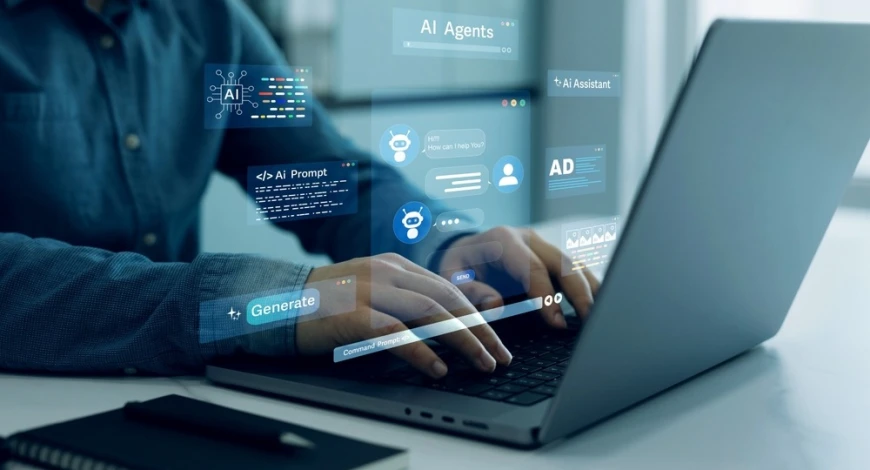How to Align Web Design and Corporate Software Integration?
Web design and corporate software integration are treated as separate projects in many organizations; yet from the user’s point of view they are parts of a single, unified experience. When a user encounters a beautiful interface that cannot connect to back-end systems, or powerful enterprise applications behind a fragile front-end, the outcome is the same: loss of trust and abandonment.
In reality, corporate success depends on strong alignment between UI/UX design decisions and integration architecture, business processes and data models. This alignment is not only a technical matter; it is also about digital transformation, change management and user-centricity. In this article, we will examine how to make web design and corporate software integration work in harmony from strategic, architectural and operational perspectives.
1. The Bridge Between Web Front-End and Corporate Back-End
In a corporate ecosystem, the web interface is often the doorway to the back-end world of CRM, ERP, HR, finance, logistics and various microservices. As users pass through this door, they intuitively seek answers to questions such as:
- How reliable and consistent is this system?
- Do my business processes really become easier here?
- Are my data and transactions transparent and under my control?
To answer these questions positively, web design and corporate integration must be aligned along the following axes:
- Screen flows running in parallel with business process flows
- Clear and consistent representation of the data model in the user interface
- Transparent reflection of technical constraints into design decisions
- Considering performance, security and experience together
2. Strategic Alignment: Matching Design Language with Business Processes
The reason many integration projects fail is not lack of technology, but lack of strategic alignment. When web design is run purely on aesthetic concerns and corporate integration purely on functionality and cost, the user is left stranded in the middle. Strategic alignment requires bringing these two worlds together in a single roadmap.
2.1. Mapping the User Journey to Process Flows
First, the user journey must be mapped, and then it must be aligned with back-end business process automation flows such as O2C, P2P and S&OP.
- How does the “Request a quote” flow connect with CRM and pricing engines?
- How does the “Place an order” flow tie into ERP, inventory and invoicing?
- How is the “Open support ticket” flow integrated with ticketing systems and SLA management?
Buttons, forms and status messages on web screens must be directly mapped to the API-centric architecture and workflows in the back-end. Users should be able to answer “Where am I, what comes next?” through the visual language of the interface.
2.2. Connecting Corporate Goals with Experience Design
The second dimension of strategic alignment is the link between corporate goals and design decisions. For example:
- Goal: Reduce manual workload of the sales team → Solution: Self-service order and status tracking screens in a customer portal.
- Goal: Improve data quality → Solution: Validation, auto-complete and integration-based checks in web forms.
- Goal: Increase transparency for customers → Solution: Clear and accessible design of order status, shipment tracking and invoice history sections.
In this sense, corporate web design is not just a “nice-looking site” but an experience tool that serves concrete KPIs.
3. Integration Architectures and Their Impact on Interface Design
Corporate integration is not only about data exchange; it is also a critical architectural layer that shapes interface behaviour. Fields shown to users, table structures, filters, status labels and error messages are all directly affected by the chosen integration architecture.
3.1. API-First Approach (REST / GraphQL)
The API-first approach is the most common pattern for connecting web interfaces to enterprise applications. REST or GraphQL-based services provide a shared data layer for both enterprise applications and web/mobile front-ends.
- Resource-centric, standardized endpoints with REST APIs
- Screen-specific, performance-oriented data queries with GraphQL
- Authorized access via OAuth 2.0 and OpenID Connect
- Protecting back-end systems through rate limiting
Web designers and front-end developers should see the structure of these APIs early on and design listing, detail, filtering and state management components accordingly. This minimizes the gap between “mock screens” and “real data.”
3.2. Process-Centric Integration with iPaaS and ESB
In more complex environments, point-to-point API integrations can become unmanageable. At this point, iPaaS (Integration Platform as a Service) or ESB (Enterprise Service Bus) solutions enter the picture. Web design interacts with these platforms in several ways:
- Loading states and waiting messages that reflect orchestration flows running in the background
- Step-based progress indicators for multi-stage processes (e.g. credit application, contract approval)
- Simple but clear user-facing messaging for services that return errors
- Meaningful reflection of process flows such as O2C, P2P and S&OP into screen flows
The goal is not to hide complex corporate integration from the user, but to control and make that complexity understandable.
3.3. ETL/ELT and How Data Flows Reflect on Design
Corporate web interfaces often communicate not only with operational systems but also with reporting, BI and data warehouse solutions. While ETL/ELT processes move data across systems, the web interface should be able to answer questions like:
- How fresh is the data in this report?
- Is this metric real-time or from a daily batch?
- Which fields are PII, and how is PII masking applied?
Designers working with ETL/ELT teams can enrich trust by adding visual cues (labels, hints, icons) for data freshness, data source and sensitive fields.
3.4. Event-Driven Approach: Event-Based Experience
Event-driven architectures turn user interactions into system events. For example:
- “Request created” → Ticket creation in the ticketing system, notifications to the relevant team and real-time updates on the user’s screen
- “Payment confirmed” → Invoice generation in ERP, email notification and status change to “completed” in the web interface
- “Pending approval task” → New item appearing in the manager’s task queue
When combined with microservices architecture, this event-driven model provides a strong integration foundation. Reflecting these events in real time on the web interface (via websockets, SSE, etc.) gives users the impression that the system is “alive and watching.”
4. Security, Authorization and Data Governance
Security is one of the most critical yet least mentioned aspects when people talk about alignment between web design and integration. No matter how beautiful the design, an insecure integration will cost the organization reputation, legal risk and operational cost.
4.1. Authentication, SSO and OAuth 2.0
For corporate users, the ideal experience is accessing all systems with a single sign-on. This typically involves:
- Integration with the corporate directory (AD/LDAP)
- Single sign-on (SSO) solutions
- Modern identity federation with OAuth 2.0 and OpenID Connect
- Additional security for critical roles through MFA (Multi-Factor Authentication)
When designing the web interface, you should create consistent, trust-building user messages for scenarios like authentication errors, session timeouts and unauthorized access.
4.2. RBAC/ABAC, PII Masking and Logging
RBAC (Role-Based Access Control) and ABAC (Attribute-Based Access Control) models are widely used in corporate integration projects. For web design to align with these models:
- Role-based visibility: Certain fields visible only to certain roles
- Field-level masking: Masking PII fields (e.g. “**** 1234”)
- Action-level restrictions: Buttons enabled/disabled based on roles/attributes
- Traceability: Transparent notifications indicating that critical actions are logged
This supports regulatory compliance and sends users the message: “This system takes data security seriously.”
5. Performance, Observability and User Experience
Even when web design and integration are aligned, poor performance still harms user experience. In microservice and integration-heavy environments, each API call can manifest as a delay that users feel directly.
5.1. Core Performance Metrics: TTFB, TTI, CLS
The following metrics are critical when assessing corporate interfaces:
- TTFB (Time to First Byte): Time to the first server response
- TTI (Time to Interactive): Time until the page becomes fully interactive
- CLS (Cumulative Layout Shift): The level of user-disrupting layout shifts
- LCP (Largest Contentful Paint): Speed of loading the main content
These metrics are directly related to integration strategy. For example, instead of bundling too many synchronous API calls into a single page, you can use lazy loading and background updates to give users a smoother experience.
5.2. Observability: Logs, Metrics and Tracing
The key to managing performance and resolving integration issues quickly is a strong observability stack.
- Detecting slow endpoints with application performance monitoring (APM)
- Measuring real-world experience via real user monitoring (RUM)
- Finding bottlenecks in integration chains through distributed tracing
- Using log correlation for end-to-end analysis of error scenarios
Web design should be iteratively improved using insights from observability, supported by A/B testing, usability tests and heat maps.
6. Real-World Scenarios: Where Alignment Becomes Tangible
To make the theory more concrete, let’s look at two scenarios: a B2B order portal and an HR self-service platform.
6.1. Scenario: B2B Order and Partner Portal
In a partner portal of a manufacturing company:
- Dealers want to see stock and price information in real time.
- Processes for placing, revising and tracking orders should be managed from a single screen.
- ERP integration for invoices and payments must work seamlessly.
In this scenario, web design should:
- Present product, price and stock data using clear cards and table components
- Provide a step-by-step order flow that parallels the O2C process
- Make ERP, CRM and payment system integration visible through status labels and notifications
6.2. Scenario: HR Self-Service Portal
In an HR portal, employees manage vacations, expenses, training and performance processes. In the background, there are integrations with HRM, payroll, accounting and document management systems. Unified design here means:
- Showing vacation request, approval and payroll reflections in a single flow
- Differentiating views for roles (manager, employee, HR)
- Providing secure, personalized screens with SSO and RBAC/ABAC
- Applying PII masking rules on expense and payroll data
This allows employees to enjoy a smooth experience without feeling the complexity of corporate integration.
7. KPI & ROI: Measurable Outcomes of Alignment
Aligning web design and integration produces measurable business outcomes. To see these outcomes, you should define KPIs for both the experience and the operations side.
7.1. Experience-Focused KPIs
- Task completion time (e.g. placing an order, creating a leave request)
- Error rate (wrong entries, abandoned forms)
- Self-service usage rate (portal use versus call center calls)
- Satisfaction scores and NPS
7.2. Operations and Integration-Focused KPIs
- Decrease in manual workload and rework rate
- Reduction in tickets caused by integration errors
- Shorter lead times for reporting and data preparation
- Improvement in process cycle times
These indicators help clearly demonstrate to top management the ROI of investing in aligned web design integration.
8. Best Practices: Recommendations for Unified Design and Integration
- Organize joint discovery workshops where UI/UX, integration and business teams sit at the same table.
- Discuss processes first, then screens and only lastly technology; avoid reversing this order.
- Share API contracts with the design team and map the data model to interface components.
- Design dedicated screen states for “happy paths” and “error scenarios” for each critical integration flow.
- Include security, performance and usability in the same quality criteria set.
- Never go live without testing with real users; create a clear iteration plan.
9. Checklist: Are Web Design and Integration Aligned?
- Are user journeys aligned with business processes (O2C, P2P, etc.)?
- Is an API-first approach adopted, and are interface components aligned with the data model?
- Are security layers like SSO, OAuth 2.0 and MFA consistently reflected in design?
- Are RBAC/ABAC and PII masking rules applied on a per-screen basis?
- Are metrics like TTFB, TTI and CLS regularly tracked?
- Is event-driven architecture supported with real-time feedback in the interface?
- Is there shared design/integration documentation for business and technical teams?
- Are self-service rates and call-center loads measured regularly?
- Is a feedback loop defined for continuous improvement?
- Are observability processes (logs, metrics, tracing) ready for post-go-live operations?
In conclusion, when web design integration and corporate software integration are handled in isolation, users are given a fragmented and unreliable experience. When processes, data models, integration architecture and UI/UX design are planned together, it becomes possible to build a smooth, secure and measurable digital experience for both internal and external users. This forms the foundation of a sustainable corporate web design culture that produces not only visual appeal but also real business value.
-
 Gürkan Türkaslan
Gürkan Türkaslan
- 17 November 2025, 10:52:30
 English
English



